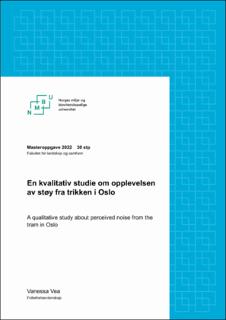| dc.contributor.advisor | Bastien, Sheri Lee | |
| dc.contributor.advisor | Olafsen, Sigmund | |
| dc.contributor.author | Vea, Vanessa | |
| dc.coverage.spatial | Norway, Oslo | en_US |
| dc.date.accessioned | 2022-07-20T14:34:03Z | |
| dc.date.available | 2022-07-20T14:34:03Z | |
| dc.date.issued | 2022 | |
| dc.identifier.uri | https://hdl.handle.net/11250/3007271 | |
| dc.description.abstract | Bakgrunn:
Støy er en av de største miljørisikofaktorene som bidrar til størst helsetap i befolkningen, og som dermed fungerer som en trussel mot folkehelsen. Trikkestøy er støyforurensende og påvirker helse og likskvalitet negativt. Økt urbanisering og befolkningsvekst fører med seg at flere vil benytte seg av kollektivtransporttilbud, slik som trikken. Til tross for at jernbanetrafikk (tog, trikk og T-bane) ansees å være det mest bærekraftige transportmiddelet, er det likevel konstatert at trikken har blitt en alvorlig urban støykilde. Jernbanetrafikk er den nest største kilden til støy (overgått av veitrafikkstøy), og i Oslo har antall personer utsatt for uakseptable støynivåer fra trikken, økt med 23% siden 2011.
Formål:
Formålet med masterstudien var å undersøke og få en dypere forståelse av hvordan voksne beboere langs trikkelinjene i Oslo, opplever støy fra trikken. Videre formål med studien var å få innsikt i hvordan støy fra trikken påvirker helsen til de støyeksponerte, samt hvilke mestringsstrategier de tar i bruk for å håndtere støyeksponering fra trikken.
Metode:
Masterstudien har benyttet kvalitativ metode, med case studie som studiedesign, og seks semi-strukturerte intervjuer for innsamling av datamaterialet. Av hensyn til covid-19 pandemien har datainnsamlingen foregått over det digitale verktøyet Zoom og e-post. Det innsamlede datamaterialet er deretter analysert med utgangspunkt i systematisk tekstkondensering (STC). Dette førte til tre hovedkategorier; støy, helse og livskvalitet, og tiltak.
Resultater:
Å være støyeksponert fra trikken i Oslo i egen bolig, opplevdes negativt for deltakerne. Trikkestøyens innvirkning har ført til økt støyplage, irritasjon, stressreaksjoner, nedsatt trivsel, og søvnforstyrrelser, hvorpå trikkestøyen medførte begrensninger i bruk av bolig og uteområder. I tillegg skapte trikkestøy sjenanse ved sosiale sammenkomster. Det har ført til endret bevegelsesmønster. Deltakerne opplever avmakt, ved at de ikke blir hørt i sine henvendelser til Sporveien AS, bydel og bydelsoverlege. Belastningen av å være eksponert for trikkestøy, har medført nedsatt livskvalitet og trivsel. Deltakerne utviklet ulike mestringsstrategier, noe som kan ha en positiv innvirkning på helse og livskvalitet.
Konklusjon:
Opplevd trikkestøy er en stressor i omgivelsene, som har negativ innvirkning på helse, trivsel og livskvalitet. Å være eksponert for trikkestøy utløste mestringsstrategier, som hadde til hensikt å fjerne stressorer. | en_US |
| dc.description.abstract | Background: Noise is one of the biggest environmental risk factors that contributes to the greatest health loss in the population, and acts as a threat to the public health. Tram noise is polluting, and has negative effects on health, and quality of life. Increased urbanization and population growth means that more people will take advantage of public transport services, such as the tram. Despite the fact that railway traffic (trains, trams and subways) is considered to be the most sustainable means of transport, it has nevertheless been established that the tram has become a serious source of urban noise. Railway traffic is the second largest source of noise (surpassed by road traffic noise), and in Oslo the number of people exposed to unacceptable levels of tram noise, has increased by 23% since 2011.
Purpose: The purpose of this study was to investigate and gain a deeper understanding of how adult residents along the tram lines in Oslo experience noise from the tram. The further purpose of this study was to gain insight into how noise from the tram affects the health of those exposed to noise, as well as what coping strategies they use to deal with noise exposure from the tram.
Method: This study has used a qualitative method with case study as study design, and six semi-structured interviews, for the collection of data material. Due to the covid-19 pandemic, the data collection has taken place via the digital tool Zoom and e-mail. The collected data material is then analyzed on the basis of systematic text condensation (STC). This led to three main categories; noise, health and quality of life, and measures.
Results: Being exposed to noise from the trams of Oslo in their own home, was experienced negatively by the participants. The impact of tram noise has led to increased annoyance, irritation, stress reactions, and a reduction in well-being, and sleep disturbances, whereupon tram noise led to restrictions on the use of homes and outdoor areas. In addition, tram noise created embarrassment at social gatherings. This has led to a change in movement patterns. The participants experience powerlessness, in that they are not heard in their inquiries to Sporveien AS, the district, and the district chief physician. The burden of being exposed to tram noise, has reportedly resulted in reduced quality of life and well-being. The participants have developed several coping strategies, which can have had a positive effect on health and quality of life.
Conclusion: Perceived tram noise is a stressor in the environment, which has a negative impact on health, wellbeing, and quality of life. Being exposed to tram noise, triggered coping strategies to remove stressors. | en_US |
| dc.language.iso | nob | en_US |
| dc.publisher | Norwegian University of Life Sciences, Ås | en_US |
| dc.rights | Attribution-NonCommercial-NoDerivatives 4.0 Internasjonal | * |
| dc.rights.uri | http://creativecommons.org/licenses/by-nc-nd/4.0/deed.no | * |
| dc.title | En kvalitativ studie om opplevelsen av støy fra trikken i Oslo | en_US |
| dc.title.alternative | A qualitative study about perceived noise from the tram in Oslo | en_US |
| dc.type | Master thesis | en_US |
| dc.description.localcode | M-FOL | en_US |

